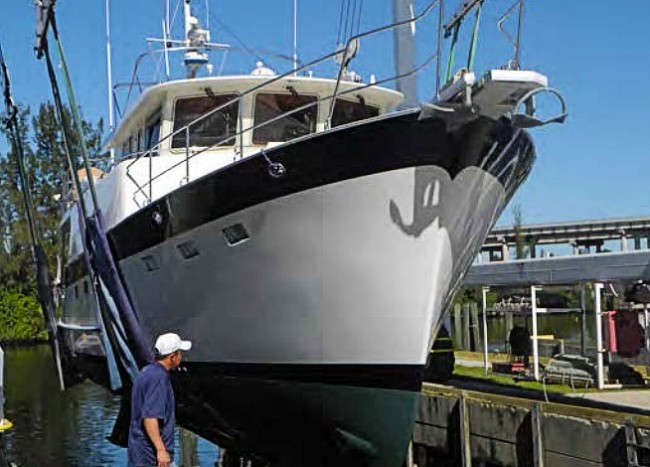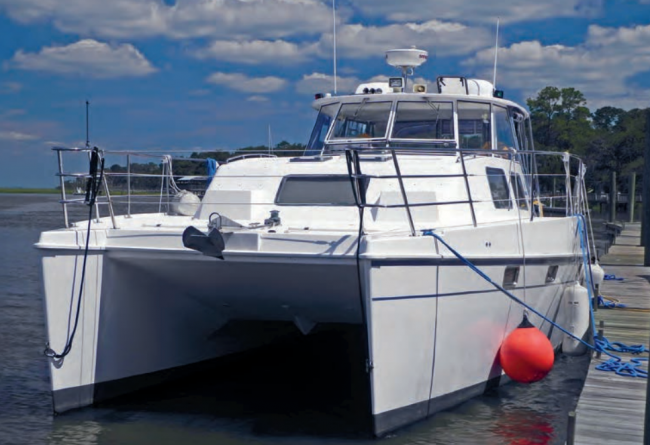
Do you dream that your 24' (7.31 m) trailer boat will somehow transform into a 34' (10.36 m) cruiser? Or maybe you already have a 32' (9.75 m) cuddy cabin and are looking to trade up to something in the mid-40s range? Size matters when finding your perfect boat. "10 foot-itis" is a term you may joke about during docktails, but this is a real condition that many boaters can't seem to shake. We can help you recognize the symptoms and prepare for your likely future with a bigger boat.
From Thirty-Something to the Fabulous Forties
Our personal experience with 10 foot-itis started in our former homeport of New Orleans. We owned a 34' (10.36 m) Downeast cruiser and were happy with our single-engine boat. Even without a bow thruster, we learned how to maneuver in close quarters. Practice creates muscle memory, which also builds confidence.
We spent many fun weekends cruising locally, but as time went on, our local day trips stretched into far-away adventures. The longer travels far from our home marina had us wondering if a bigger boat would suit us better. The simple answer: Yes.

We looked longingly at the newer, larger yachts like kids in a toy store. Our 10' (3.05 m) jump brought us to a 44' (13.41 m) trawler with twin engines, a generator and more of everything. The difference when increasing livable space is immediately evident and appreciated. The bigger boat gave us two staterooms, two heads and showers, a larger aft deck, larger saloon and galley and a better ride in the seas. So yes, it was good decision for us.
Every long weekend we set out in our mini armada with the smaller boats pulling up the rear. No doubt the smaller-boat captains in our flotilla were fighting off the 10 foot-itis bug themselves. A few succumbed despite their valiant efforts, while other hearty specimens managed to treat the symptoms down to only 2 foot-itis, which is a much more manageable transition. After a month-long cruise to test the big idea in our head, we were hooked. We loved the month away from the land-based world. Now our future plans included long-range cruising.
With the larger trawler rigged for everything short of crossing oceans, we did it. We sold the house and moved aboard full time, along with our two Labrador Retrievers. We said goodbye to New Orleans and took off at 7 knots, never looking back… well, maybe just to check that we were still in the channel.
Considering Insurance Coverage
We innocently stepped up the boat ladder 10' (3.05 m) at a time. Unknowingly, our gradual jumps in boat size gave us a history for the insurance company for future consideration. Starting with a 14' (4.27 m) skiff, we transitioned to a variety of boats including a 26' (7.92 m) cuddy. Our next trade up to a 34' (10.36 m) lobster boat wasn't so dramatic, but even that morphed into owning a 44' (13.41 m) trawler.
That, along with our professional mariner background, never raised a question about our insurability. We simply called our insurance broker and they upped the covered value. But that is not the norm anymore.
Let's talk what the norm is now. Today the pleasure marine industry includes many first-time boat owners buying big boats right from the start. These new owners have never experienced 10 foot-itus. The lack of experience in bigger boats — or any boat in some cases–may be a concern when trying to get insurance or a boat loan.
In aircraft there is the term "time in type," meaning how much time do you have in a particular type of aircraft. If you want to progress from a single-engine Piper to a twin-engine Cessna, training will be required in the larger twin-engine aircraft before you can be licensed to operate them. Boats have similar progressive steps, not from single to twin engines, but from a smaller, more maneuverable boat to a larger, more complicated boat.
Big boats respond differently than smaller boats and are more system intensive, requiring continued maintenance. A larger, heavier boat takes longer to get moving and requires more effort to stop. This addresses concerns with docking a larger boat in tight quarters. Of course, thrusters would be helpful but the insurance underwriter's computers may not have that factor in their underwriting algorithm.
What is the Solution?
An ounce of prevention is worth a pound of cure so don't wait to find an insurer until you are ready to purchase your dream boat. Start thinking about the type and size of boat that will fit your needs and desires. We believe that the best solution is to hire a training captain … even before you buy the boat. Meet with a training captain to discuss the realities of the boat you are considering and put together a plan to present to the lender and insurer.
Many insurance companies have checklists or time requirements that a training captain can document for you. This will put you miles ahead when starting your boat search. Many lenders and insurers create profiles of owners and you need to be in the "good risk" category. If you don't have experience to offer for historical data, then training is essential. A professional training captain can also help you learn to own and operate your new boat, whether it's your first boat or your first big boat. After training is complete, the captain can provide a letter of confidence to your insurer that you are a good risk as a boat owner and operator.
Size Matters
Reflect on your cruising goals, whether they include a local vacation, spending a season on Chesapeake Bay, completing America's Great Loop or traveling north and south as a snowbird. And don't forget to consider the Bahamas. After deciding where you want to cruise, you can better determine the type of boat that will bring you joy. Are you planning to be a full-time liveaboard without a home address or a long-term cruiser occasionally returning to a land residence? Will you have frequent guests or are you a solo sailor? There's a cure for 10 foot-itis but first you need to recognize your symptoms, define possible solutions and explore insurance options.
Captains Chris & Alyse Caldwell are USCG 100-ton Masters and Cruising Coaches who offer Personal Boat Training Online or Onboard your boat anywhere! The Caldwells help build your cruising confidence with hands-on training, with their AskCaptainChris.com training videos and through two-day seminars filled with tons of tips for the boater who loves learning and now remote learning. If you have additional questions for Captains Chris or Alyse, please email them at chris@captainchrisyachtservices.com











